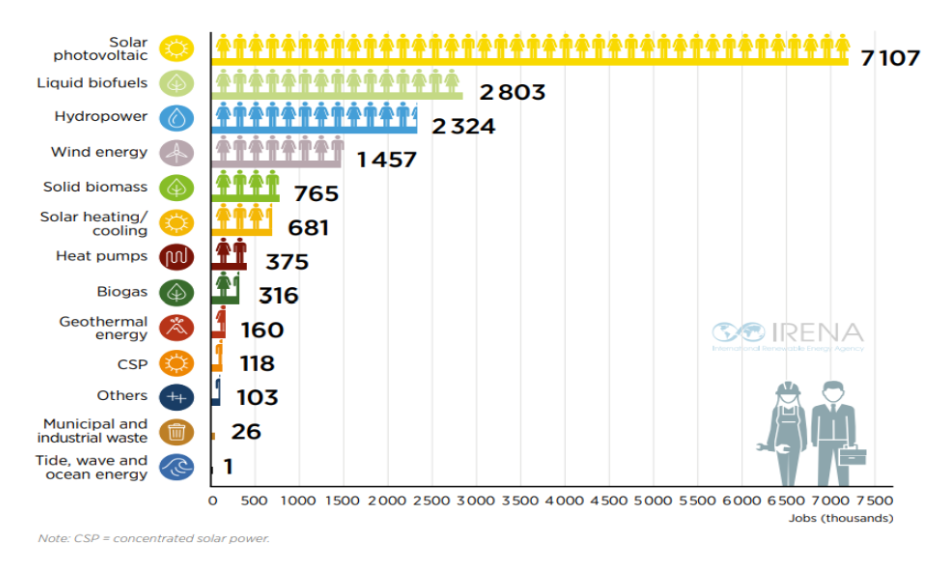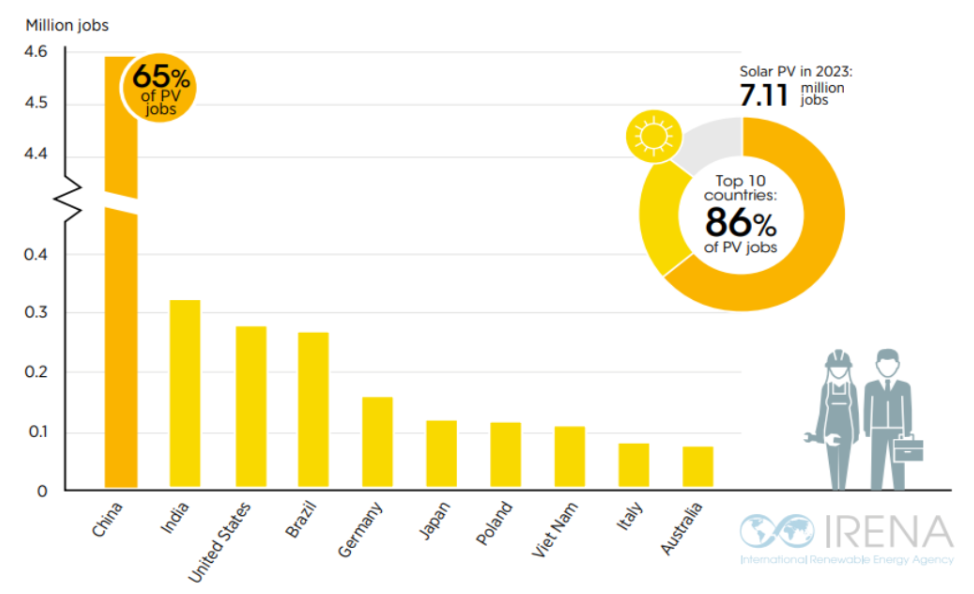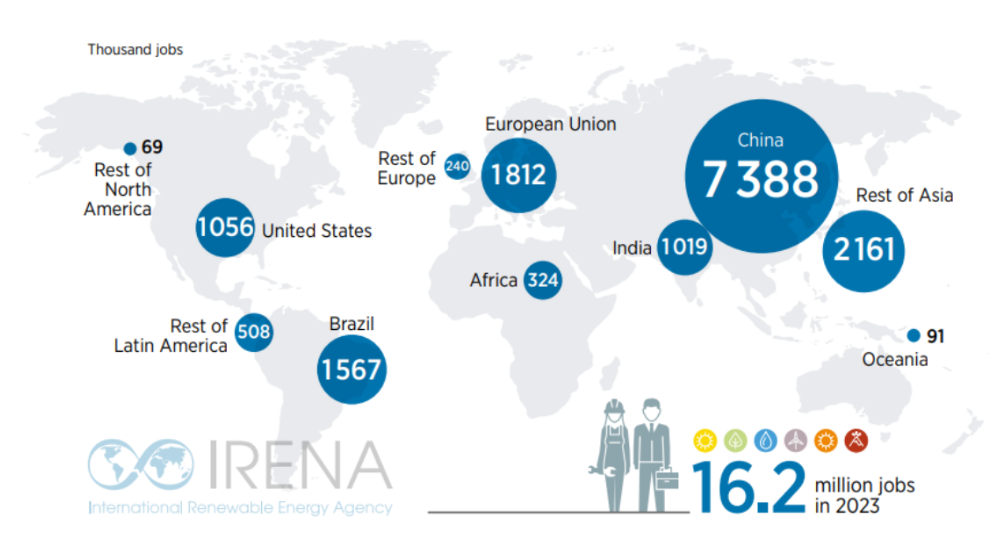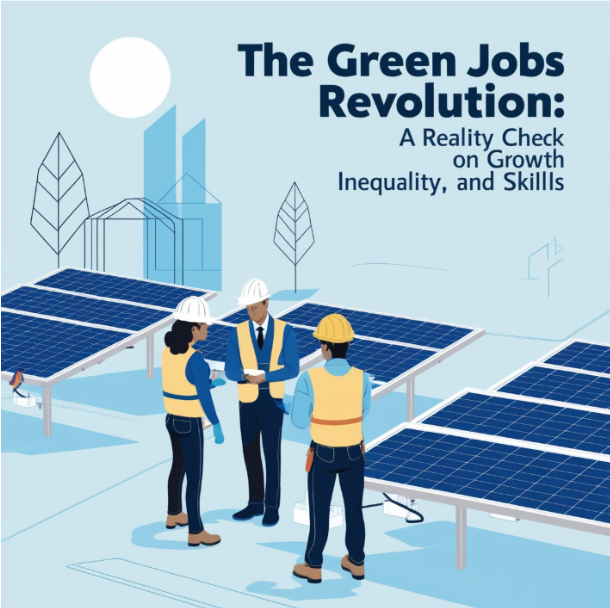The recently released Renewable Energy and Jobs – Annual Review 2024, published by the International Renewable Energy Agency (IRENA) and the International Labour Organization (ILO), presents both promising and concerning insights into the green job sector. With the global renewable energy deployment expected to grow threefold by 2030, the report highlights that renewable energy jobs surged to 16.2 million in 2023,up from 13.7 million in 2022. While these numbers are encouraging, they don’t paint a complete picture of the future of employment in this sector. Despite its growth, the renewable energy industry faces pressing challenges, including the uneven distribution of resources, an alarming gender imbalance, skills shortages, and policy gaps .
Global Picture: Disparities in Renewable Energy Employment
Renewable energy-related employment is primarily driven by factors such as the increasing global deployment of renewable technologies, the evolving dynamics of industries that manufacture equipment, and the growing demand for related services like project planning, permitting, and financing.
In 2023, approximately 473 gigawatts (GW) of new renewable electricity generation capacity were added globally, bringing the total capacity to 3,865 GW. This marks an impressive 14% increase compared to 2022, making it the largest annual growth ever record
First, there is an unequal distribution of jobs across different countries, with some nations having a much higher concentration of employment in this sector than others. Second, there is an imbalance in the types of renewable energy technologies that generate jobs, with certain technologies dominating the market and creating more opportunities than others.This disparity can result in unequal economic development, with some regions missing out on job opportunities in the renewable energy sector, potentially widening social and economic inequalities. It also leaves countries reliant on a few technologies, making them vulnerable to market shifts or technological changes.
Technology wise distribution
In 2023, the solar PV sector saw a record addition of 347 GW, marking a 74% increase over 2022. This growth in capacity led to a substantial rise in employment within the industry, creating 7.1 million jobs, up from 4.9 million the previous year. These jobs accounted for 44% of the total renewable energy workforce globally.

Source: Renewable Energy and Jobs, Annual Review 2024
Employment in the solar industry is mainly concentrated in two key areas: manufacturing and installation/maintenance. Manufacturing involves producing solar equipment, especially panels, and is a significant source of direct jobs. It is estimated that every 1 GW of module production capacity creates between 1,085 and 2,020 jobs, depending on regional labor demands. The second major area is installation and maintenance, encompassing both rooftop and ground-mounted systems. These roles are critical for deploying new solar projects and ensuring their long-term performance, making them a vital component of job creation in the sector.

Source: Renewable Energy and Jobs, Annual Review 2024
Among the top ten countries for solar PV employment, four are in Asia, three in Europe, two in the Americas, and one in Oceania. Together, these top ten nations account for 86% of total PV employment worldwide. With China leading the way, Asian countries account for 77% of the total solar PV jobs. India comes in second globally, employing about 320,000 people in this sector. Europe holds a 10.7% share of the jobs, followed by the Americas at 8.6%, while all other regions together make up the remaining 3.3%.
Bioenergy is the second-largest employer in the renewable energy sector, providing 2.8 million jobs globally in 2023, following solar energy. Most biofuel jobs are found in the agricultural supply chain rather than at biorefineries. The number of jobs created in feedstock production varies by region. Industrialized nations rely on mechanized farming, which needs fewer workers, while developing countries use labor-intensive methods that generate more jobs, often in informal or seasonal roles.
Latin America leads in bioenergy employment, accounting for 43% of global biofuel jobs, with Asia following closely at 39%. North America and Europe contribute smaller shares, at 12% and 6%, respectively.
Hydropower and wind energy are the next largest employers in the renewable sector, providing 2.3 million and 1.5 million jobs, respectively. China dominates in both areas, employing the largest workforce, while India also plays a significant role, particularly in wind energy, which is set to expand further. However, global hydropower development is slowing, leading to a 16% drop in direct jobs across major markets.
Country wise distribution : China’s Unmatched Dominance
Out of 16.2 million renewable energy jobs worldwide, China leads with 7.4 million, representing 46% of the total. The European Union follows with 1.8 million jobs, while Brazil accounts for 1.6 million. The United States and India contribute just over 1 million jobs each.
China’s dominance in the renewable energy market is unparalleled. Its cumulative solar PV capacity is over four times that of the United States and 1.5 times greater than the combined capacity of the next ten leading countries. Alongside its leadership in capacity installations, China is also the top equipment manufacturer in the rapidly growing wind and solar PV sectors, cementing its position as a global leader.
Europe collectively accounts for 1.8 million renewable energy jobs, largely concentrated in wind and biofuels. This underscores Europe’s role as the second-largest player in wind equipment installation and manufacturing. Brazil, with 1.57 million jobs in 2023, driven by its strong position in the hydropower and biofuel sectors. The country also added 11.9 GW of solar PV capacity in 2023, ranking fourth globally in the solar market after China, the U.S., and Germany.

Source: Renewable Energy and Jobs, Annual Review 2024
India’s Position: A Promising Future Ahead
In 2023, India’s renewable energy sector provided jobs to an estimated 1.02 million people. Hydropower led the sector with approximately 453,000 jobs, followed by solar PV with 318,600 positions across on-grid and off-grid systems. Wind energy contributed 52,200 jobs, while additional opportunities arose in liquid biofuels, solid biomass, solar heating and cooling, and biogas, highlighting the sector’s wide-ranging employment potential.
India’s clean energy manufacturing sector is growing rapidly, driven by government initiatives like the Production-Linked Incentive (PLI) scheme. These programs aim to establish India as a major manufacturing hub for clean energy components, reducing reliance on imports from countries like China. This shift has drawn significant investments. For instance, Ford, who once left India, now plans to repurpose its Chennai facility for EV manufacturing, creating over 3,000 jobs. Similarly, Tata Motors is investing $1.5 billion in a lithium-ion battery plant in Gujarat while expanding support for the country’s EV infrastructure.
India added 9.7 GW of new solar PV capacity, bringing its total capacity to 72.7 GW in 2023. This achievement ranked India fifth globally for both new installations and overall capacity.India’s operational solar module manufacturing capacity was 46 GW in 2023, with expectations to grow to 58 GW in 2024. Similarly, its cell manufacturing capacity is projected to increase from 26 GW to 32 GW during the same period, positioning India as the second-largest PV manufacturer worldwide, behind only China.
India’s solar PV exports, particularly to the U.S., have surged, thanks to incentives under the U.S. Inflation Reduction Act. In 2023, India saw a rise in grid-connected solar PV jobs, reaching 238,000, an 18% increase from the previous year. Additionally, 80,000 people were employed in the off-grid solar sector.
The report highlights the revival of India’s wind power sector, which had experienced slow growth over the past five years. With a cumulative installed capacity of 44.7 GW, India now ranks fourth globally in wind energy. In 2023, India added 2.8 GW of wind capacity,significantly higher than in recent years, although still below the peak of 4.1 GW in 2017.
India’s wind component manufacturing is also advancing, particularly in response to U.S. tariffs on Chinese wind products like gearboxes. This shift has encouraged global manufacturers to expand production in India, allowing the country to surpass Europe as the second-largest gearbox production hub worldwide. The wind sector employed 52,200 people in 2023, with nearly 40% in operations and maintenance (O&M) and about 35% in construction and installation.

Source: Renewable Energy and Jobs, Annual Review 2024
Skill Gap Stalls Global Clean Energy Progress
As the world accelerates its energy transition, the emphasis is often placed on increasing installation capacity .However, many countries fail to recognize the importance of investing in skill development to achieve these goals. Without a focus on upskilling, the transition can lead to a shortage of qualified workers. Skill development is not just about enhancing employability; it plays a vital role in filling critical job positions, driving industry innovation, and supporting the evolution of the sector. By investing in skill development, countries can ensure a smooth transition, empowering the workforce to embrace new technologies and industry changes while creating opportunities for all.
The rapid growth of renewable energy is outpacing the development of a skilled workforce. For instance, Europe is experiencing a shortage of electricians, installers, and fitters across various sectors, while many developing countries struggle with a lack of university graduates with STEM backgrounds. The growing demand in the renewable energy sector is particularly focused on mid-skilled labor, such as installers, electricians, plumbers, welders, and hydropower operators.
With the ongoing technological revolution, there is an increasing need for reskilling and upskilling of current technicians and skilled workers.For a successful energy transition, policies on skills, energy, and employment must work together efficiently, avoiding overlap and boosting effectiveness. This requires collaboration between governments, businesses, workers, community groups, and education providers at all levels.
Gender Imbalance: The Silent Barrier to Renewable Energy Growth
Research shows that, despite expected job growth in renewable energy, this does not ensure equal opportunities for men and women. While women’s participation is better in renewable energy than in fossil fuels, the energy sector remains largely male-dominated, with a notable gender imbalance similar to other major industries. According to IRENA, women make up only one-third of the global renewable energy workforce, often lagging in leadership and technical roles. This gender gap is driven by barriers such as unequal access to education, limited technical training for women, and restrictive company policies.
Take the case of the U.S., where women make up 47% of the workforce yet hold only 26% of jobs in the energy sector. In 2023, women filled just 19% of newly created energy jobs. Their representation varies across fields,women hold 30% of roles in wind and solar energy, compared to 34% in nuclear power. African Americans are also underrepresented, holding just 9% of energy jobs despite making up 13% of the U.S. workforce. These figures highlight persistent barriers for women and minority groups to equal opportunity in the energy industry, even in a developed nation like the U.S.
The gender gap in science, technology, engineering, and mathematics (STEM) education remains a major barrier to women entering green jobs.These skills are especially important in fields like engineering, renewable energy, and technology, which play a key role in driving innovation. Despite significant progress in higher education, women still represent less than one-third of the STEM workforce. Research indicates that countries with a higher share of STEM-educated workers and stronger gender equality policies tend to have lower greenhouse gas emissions .
According to IRENA’s 2023 Solar PV: A Gender Perspective report, women make up 40% of full-time workers in the solar PV industry, a significantly higher share than in the wind and oil and gas sectors. Most women in solar PV are in administrative roles, where they account for 58% of the workforce. Their presence is lower in technical non-STEM roles, at 38%, and even lower in STEM-specific positions, at 32%.Women also remain underrepresented in leadership positions, holding a smaller percentage of managerial and senior management roles. . The solar PV manufacturing sector has the highest female representation, with 47% of the workforce, while only 12% of solar PV installers are women.
Women in Decentralized Renewable Energy
Decentralized renewable energy(DRE), especially off-grid solar, has proven to be an ideal solution for bringing electricity to rural, and hard-to-reach areas. A 2024 study titled Decentralised Solar PV: A Gender Perspective by IRENA highlights the barriers women face in joining the decentralized solar PV workforce, offering strategies to improve gender inclusion. In 2023, over 300,000 people were employed in this sector across Ethiopia, India, Kenya, Nigeria, and Uganda, yet women represented only a small share of these jobs.
While equipment like solar panels can be manufactured anywhere, most jobs in DRE are inherently local or community-based. The stand-alone nature of many off-grid systems means that roles in sales, customer service, community engagement, installation, and maintenance are most effectively carried out locally. This localized approach supports diverse job opportunities that fit a variety of skills and backgrounds. Additionally, expanding energy access to remote areas can stimulate indirect employment by enabling affordable electricity for households and businesses, driving economic growth in these regions.
Women in decentralized solar PV often encounter societal and structural barriers that limit their participation and growth. Cultural norms frequently position technical roles as “men’s work,” while caregiving expectations place additional demands on women, making it harder for them to engage fully in these fields. These societal pressures can also impact women’s confidence, leading them to question their suitability for technical roles.
Beyond cultural challenges, women face gender bias from employers and customers, persistent pay gaps, limited mobility due to safety concerns, inflexible workplace policies, and a shortage of gender-sensitive policies. Addressing these obstacles calls for initiatives that support women’s skill-building, targeted outreach to raise awareness, and the development of a gender-responsive work environment that encourages women’s active participation and entrepreneurship in renewable energy.
Women participation in India
Women make up 47% of India’s population, but their contribution to the country’s GDP is only 18%, highlighting a significant gender gap. In the renewable energy sector, this gap is even more pronounced. An ongoing study by CEEW and MNRE, which surveyed 165 companies across various segments, found that women make up less than 15% of the renewable energy workforce. Their roles are predominantly non-technical, focusing on areas such as human resources and finance, with very few women in senior management or leadership positions.
The gender imbalance is also evident across different sectors within the renewable energy space. According to a 2022 IEA study, women account for only 11% of the workforce in India’s rooftop solar sector, far lower than the global average of 32%. However, this is still a higher representation compared to energy sectors like coal, oil, and gas. Women’s participation in rooftop solar varies across the value chain, with more women in the design, pre-construction, and corporate phases, which primarily consist of office-based jobs.
In contrast, women’s presence drops significantly in on-site roles like construction, commissioning, and operations and maintenance. In these areas, their participation is as low as 3% in construction and 1% in operations and maintenance. The need for frequent site visits and on-the-ground work in these roles remains a significant barrier to greater female involvement
India produces a large number of women graduates in STEM fields, yet their presence in the workforce remains disproportionately low. While women make up about 43% of STEM graduates, they hold only 14% of STEM jobs.While access to education has improved, securing meaningful employment remains a major challenge for women. However, in the decentralized renewable energy (DRE) sector, women have slightly better representation compared to other areas of renewable energy. This is largely due to DRE technologies being deployed within or near communities, which presents accessible entrepreneurial opportunities for women and promotes greater local involvement.
Conclusion
The IRENA report concludes by highlighting two main paths for the energy transition: the “costs-and-profits” model and the “people- and planet-centered” approach. The first prioritizes rapid deployment at minimal costs, often placing shareholder interests above social and environmental concerns. In contrast, the second approach focuses on creating local value, ensuring decent working conditions, supporting community participation, and emphasizing environmental sustainability.
The growth of renewable energy involves not only the number and distribution of jobs but also their quality. The current industry often prioritizes cost reduction, leading to global competition that undermines domestic manufacturing and job creation. This dynamic, driven by cost pressures, has led to job losses and economic instability, potentially undermining public support for the transition.
To ensure a more equitable and sustainable energy transition, public policy should play an active role in shaping outcomes. This involves not only incentivizing private investment but also ensuring that projects benefit local communities, create gender balanced jobs, and meet sustainability goals. Additionally, policies must address the employment challenges in fossil fuel industries, providing support for workers transitioning to new roles in the renewable sector.
Based on the report, Harshit Poddar, founder of SafEarth Renewables, stated, “The success of the energy transition relies on a blend of policies that not only accelerate the deployment of renewable energy but also create jobs, benefit communities, and promote environmental sustainability. An ideal transition requires a framework that includes access to affordable finance, supportive policy structures, committed institutions, and public acceptance. At SafEarth, we are dedicated to guiding industries through this journey. With over 400 MW of solar deployment, we have already generated significant employment opportunities in the market and aim to continue driving measurable change for businesses, communities, and the planet.”
While cost reductions are essential for scaling up renewable energy, these efforts should not come at the expense of worker rights, environmental sustainability, or social equity. A responsible approach to the energy transition includes considering the long-term impacts on labor, community well-being, and the environment, ensuring that the benefits of renewable energy are broadly shared.

